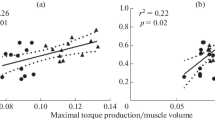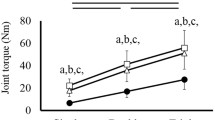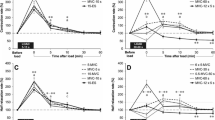Summary
The aim was to study the methodological aspects of the muscle twitch interpolation technique in estimating the maximal force of contraction in the quadriceps muscle utilizing commercial muscle testing equipment. Six healthy subjects participated in seven sets of experiments testing the effects on twitch size of potentiation, time lag after potentiation, magnitude of voluntary force, stimulus amplitude, stimulus duration, angle of the knee, and angle of the hip. In addition, the consequences of submaximal potentiation on the estimation of maximal force from twitch sizes were studied in five healthy subjects. We found an increase in twitch size with increasing levels of potentiation and twitch size decreased exponentially following potentiation. We found a curvilinear relationship between twitch size and voluntary force, and these properties were more obvious when the stimulation intensity of the preload was reduced. The relationship between twitch size and force was only linear, for force levels greater than 25% of maximum. It was concluded that to achieve an accurate estimate of true maximal force of muscle contraction, it would be necessary for the subject to be able to perform at least 75% of the true maximal force.
Similar content being viewed by others
References
Alway SE, Hughson FU, Green AE, Patla AE, Frank JS (1987) Twitch potentiation after fatiguing exercise in man. Eur J Appl Physiol 56:461–66
Amundsen LR (1990) Muscle Strength Testing. Churchill Livingstone, New York
Belanger AY, McComas AJ (1981) Extent of motor unit activation during effort. J Appl Physiol 51:1131–1135
Bigland-Ritchie B (1984) Muscle fatigue and the influence of changing neural drive. Clin Chest Med 5:21–34
Bigland-Ritchie B, Cafarelli E, Vøllestad NK (1986a) Fatigue of submaximal static contractions. Acta Physiol Scand 128:137–148
Bigland-Ritchie B, Furbush F, Woods JJ (1986b) Fatigue of intermittent submaximal voluntary contractions: central and peripheral factors. J Appl Physiol 61:421–429
Chapman AE (1985) The mechanical properties of human muscle. Exerc Sport Sci Rev 13:443–501
Edwards RHT, Young A, Hosking GP, Jones DA (1977) Human skeletal muscle function; description of tests and normal values. Clin Sci Mol Med 52:283–90
Gandevia SC, McKenzie DK (1988) Activations of human muscles at short muscle lengths during maximal static efforts. J Physiol 407:599–613
Hales JP, Gandevia SC (1988) Assessment of maximal voluntary contraction with twitch interpolation: an instrument to measure twitch responses. J Neurosci Meth 25:97–102
Hortobagyi T, Lambert NJ (1992) Influence of electrical stimulation on dynamic forces of the arm flexors in strength-trained and untrained men. Scand J Med Sci Sports 2:70–75
Hurley MV, Newham DJ (1993) The influence of arthrogenous muscle inhibition on quadriceps rehabilitation of patients with early unilateral osteoarthritic knees. Br J Rhematol 32:127–31
Jacobsen S, Wildschiødtz G, Danneskiold-Samsøe B (1991) Isokinetic and isometric muscle strength combined with transcutaneous electrical muscle stimulation in primary fibromyalgia syndrome. J Rheumatol 18:1390–3
Lloyd AR, Gandevia SC, Hales JP (1991) Muscle performance, voluntary activation, twitch properties and perceived effort in normal subjects and patients with the chronic fatigue syndrome. Brain 114:85–98
Merton PA (1954) Voluntary strength and fatigue. J Physiol 123:553–564
Rutherford OM, Jones DA, Newham DJ (1986) Clinical and experimental application of the percutaneous twitch superimposition technique for the study of human muscle activation. J Neurol Neurosurg Psychiatry 49:1288–91
Stokes MJ, Cooper RG, Edwards RHT (1988) Normal muscle strength and fatigability in patients with effort syndromes. BMJ 297:1014–1017
Thomas CK, Johansson G, Westling G, Bigland-Ritchie B (1990) Twitch properties of human Thenar motor units measured in response to intraneural motor-axon stimulation. J Neurophysiol 64:1339–46
Vandervoort AA, Quinlan J, McComas AJ (1983) Twitch potentiation after voluntary contraction. Exp Neurol 81:141–52
Vøllestad NK, Sejersted OM, Bahr R, Woods JJ, Bigland-Ritchie B (1988) Motor drive and metabolic responses during repeated submaximal contractions in humans. J Appl Physiol 64:1421–1427
Westing SH, Seger JY, Thorstensson A (1990) Effects of electrical stimulation on eccentric and concentric torque-velocity relationships during knee extension in man. Acta Physiol Scand 140:17–22
Author information
Authors and Affiliations
Rights and permissions
About this article
Cite this article
Bülow, P.M., Nørregaard, J., Danneskiold-Samsøel, B. et al. Twitch interpolation technique in testing of maximal muscle strength: Influence of potentiation, force level, stimulus intensity and preload. Europ. J. Appl. Physiol. 67, 462–466 (1993). https://doi.org/10.1007/BF00376464
Accepted:
Issue Date:
DOI: https://doi.org/10.1007/BF00376464




